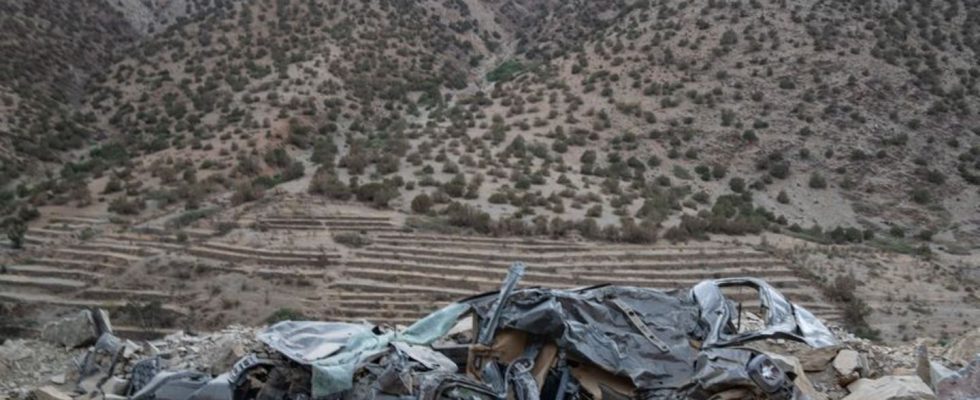Hundreds of people are still missing after the severe earthquake in Morocco that killed several thousand people. Helpers have already arrived from some countries.
Severe destruction, suffering and despair: several thousand people died in the worst earthquake to hit Morocco in decades. There are also injured and hundreds missing. As the Moroccan Interior Ministry announced on Sunday afternoon, the number of confirmed deaths rose to 2,122 and at least 2,421 people were injured. Rescue and recovery forces continue to search for survivors in the accident areas. However, the helpers are only making progress with difficulty in the sometimes remote mountain regions.
There was also still a risk of aftershocks, which could cause damaged buildings to collapse completely. The 6.8 magnitude earthquake shook Morocco on Saturday night. Panic broke out among the population. According to the World Health Organization (WHO), more than 300,000 people in Marrakech and surrounding areas are affected by the accident. The full extent of the disaster could not yet be predicted on Sunday; there were fears that the number of victims would continue to rise. King Mohammed VI ordered three days of national mourning.
Earthquakes are relatively rare in North Africa
When searching for people buried as a result of an earthquake, experts speak of a time window of around 72 hours. This applies as a guide value, which is the longest a person can get by without water. The quake occurred on Friday evening at 11:11 p.m. local time. It was felt within a radius of 400 kilometers, said Nasser Jabour, head of a department at the National Institute of Geophysics, to the Moroccan news agency MAP. The earth shook for several seconds. According to the US Earthquake Observatory USGS, the quake occurred at a depth of 18.5 kilometers.
The epicenter was a good 70 kilometers southwest of Marrakesh in the Atlas Mountains. There are towns along steep and winding serpentines. Since earthquakes occur relatively rarely in North Africa, experts believe that buildings are not built robustly enough to withstand such strong shaking.
Stronger aftershock scares people again
People in the region told dpa reporters on Sunday that in the village of Moulay Brahim alone, 50 kilometers south of Marrakech, half of the 84 residents had died. A small mountain village in Chichaoua province was almost completely destroyed, state broadcaster TV 2M reported. Drones were used to help emergency services search for bodies.
Most people in the areas affected by the quake also spent Sunday night outdoors. Since then, several aftershocks have shaken the country. There was a stronger quake on Sunday morning around 9:00 a.m. local time; according to the US Earthquake Observatory USGS, it had a magnitude of 3.9. According to Hespress, the epicenter of the aftershock was about 80 kilometers southwest of Marrakesh, similar to the first quake.
Sympathy and condolences from all over the world
Messages of condolence came from all over the world. The heads of state and government of the European Union also offered their help and expressed their condolences in a letter to the king. The Foreign Office said on Sunday afternoon that there was no knowledge of whether Germans were among the victims. The German embassy in Rabat set up an emergency number for affected Germans.
Federal Foreign Minister Annalena Baerbock (Greens) wrote on the platform fighting for the lives of the many injured.” Chancellor Olaf Scholz also expressed his condolences. “This is bad news from Morocco,” the SPD politician explained on
A special Spanish military unit with search dogs flew to Morocco on Sunday. Members of the Fire Department without Borders from Spain and other professional fire departments were also on the move. The Gulf emirate of Qatar sent a rescue and search team, reported the Qatari news agency QNA. A relief team also set off from Tunisia on Saturday evening.
So far no request for help from Germany
Relief workers were also available in Germany and other countries, but they were no longer expecting to be deployed on Sunday. “There has been no request for help from Morocco so far,” said a spokesman for the aid organization ISAR Germany and the Federal Association of Rescue Dogs. “We’re now driving everything back, clearing out our camp and unpacking our backpacks.” The Federal Agency for Technical Relief (THW) also sent its helpers, who had already been assembled near Cologne/Bonn airport for a possible rescue operation in Morocco, back home for the time being. The team remains operational, it was said.
The International Federation of Red Cross and Red Crescent Societies announced in Geneva that it would support the Red Crescent rescue workers with one million Swiss francs (one million euros). The Moroccan helpers will use the money from the umbrella company to buy important supplies locally. “The challenges are huge,” said IFRC crisis manager Caroline Holt. Bringing heavy rescue equipment to remote earthquake areas and quickly helping seriously injured people is currently the most important thing.
Despite the tension, neighboring Algeria is also helping
Due to the serious consequences of the disaster, diplomatic tensions also took a back seat: Algeria announced that it would send rescue teams to the neighboring country and offer an emergency plan. Algeria and Morocco have no longer had diplomatic relations since August 2021. The reason was “hostile actions by Rabat,” the Algerian government said at the time. The dispute was over areas in Western Sahara. In this context, Algeria closed the airspace to all Moroccan aircraft. On Saturday, Algeria announced that it would reopen its airspace for flights carrying wounded and injured people and to transport humanitarian aid to the neighboring country.
The northwest African country has around 37 million inhabitants and is around 446,000 square kilometers in size. It lies on the so-called African plate, one of the largest continental plates in the world. According to the Potsdam Georesearch Center (GFZ), during the earthquake, floes on the African plate and the Eurasian plate, which lies north of it, moved jerkily against each other.

